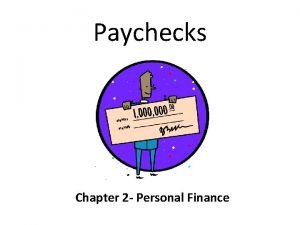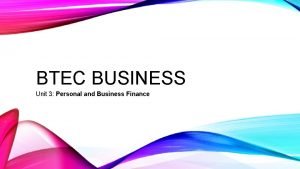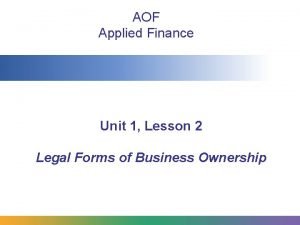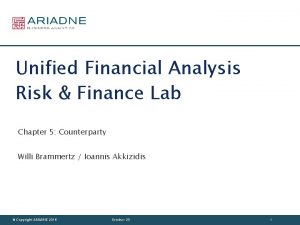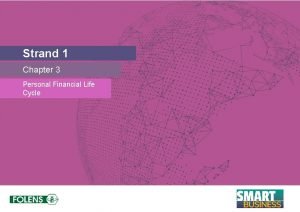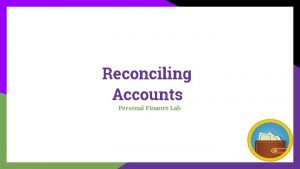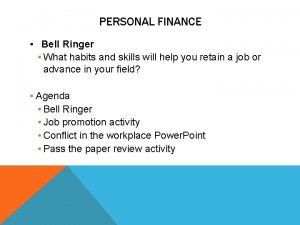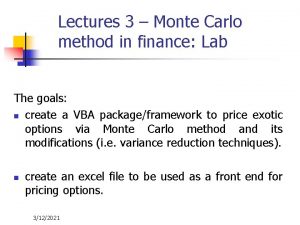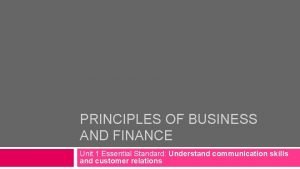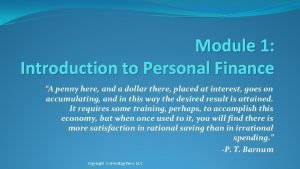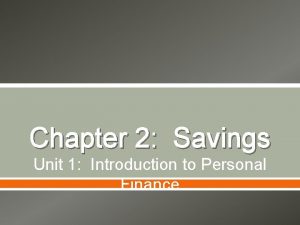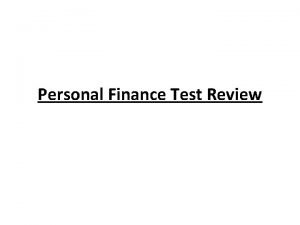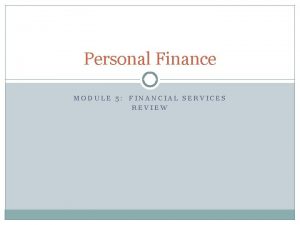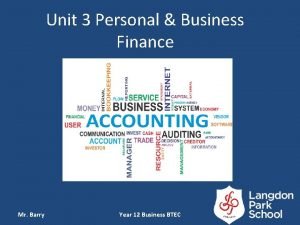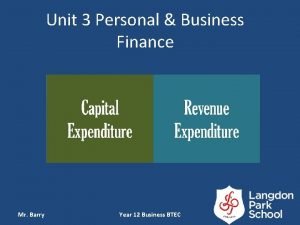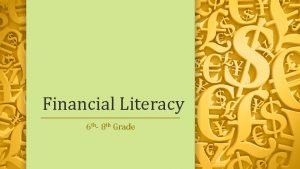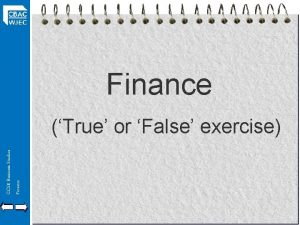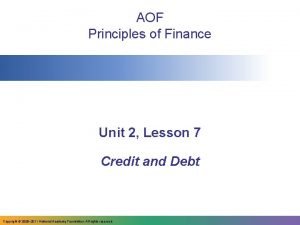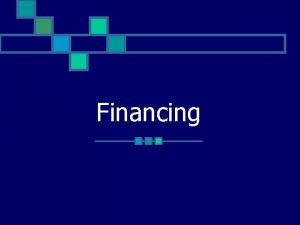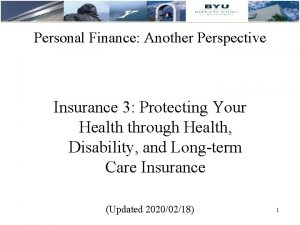Personal Finance Another Perspective Family 3 Financing your























































- Slides: 55

Personal Finance: Another Perspective Family 3: Financing your Children’s Education and Missions Updated 2020/03/24 1

Objectives A. Understand how education relates to your vision and goals and the principles of financing education and missions B. Understand the process of selecting investment vehicles for financing education and missions for your children C. Understand how to save for your children’s education and missions and how to reduce the cost of education and apply for aid D. Understand how to prepare mission and education plans 22

Your Personal Financial Plan • Section XV: Children’s Education and Mission Plans • What are your vision and goals to help your children with education and missions (use template PFP Auto Home Education Mission Strategy (LT 14)) • What are you planning to do? • What are your plans and strategies for your children’s mission and education? • This may include how you will help, how much you will help, why you will help, etc. • What are your constraints and accountability 33

A. Understand How Education Relates to Financial Goals and the Principles Median Level of Education Annual Earnings* Lifetime Earnings Not a HS graduate $24, 325 $973, 000 High school Diploma 32, 600 1, 304, 000 Some College, no degree 38, 675 1, 547, 000 Associate's Degree 43, 175 1, 727, 000 Bachelor’s Degree 56, 700 2, 268, 000 Master’s Degree 66, 775 2, 671, 000 Doctoral Degree 81, 300 3, 252, 000 Professional Degree 91, 200 3, 648, 000 *Annual earnings is lifetime earnings divided by 40 years. Source: Anthony P. Carnevale, Stephen J. Rose, and Ban Cheah, “The College Payoff: Education, Occupations, Lifetime Earnings, ” Georgetown University Center for Education and the Workforce, 2012. 44

Does Education Pay? • Is education a good investment? • President Gordon B. Hinckley said: • Now is the season to train your minds and your hands for the work you wish to do. Education can prove to be the wisest and most profitable investment you will ever make (Tambuli, Sept. 1989, 49). • He further counseled: • Get all the schooling you can. Education is the key that unlocks the door of opportunity. God has placed upon this people a mandate to acquire knowledge “even by study and also by faith” (D&C 88: 118) (“Some Thoughts on Temples, Retention of Converts, and Missionary Service, ” Ensign, Nov. 1997, 49). 5 5

Should You Pursue an Education? President Hinckley said: • You young people, the little decisions that you make can so affect your lives. Shall I go to school or not? Shall I continue on with my education? That is a big decision for some of you. Our doctrine suggests, although there may be some circumstances that would affect that decision, that the more education you receive the greater will be your opportunity to serve. That is why this Church encourages its young people to get the schooling that will qualify them to take their places in the society in which they will become a part. Make the right decisions. Take a long look (Pocatello, Idaho, regional conference, Idaho State University, 4 June 1995). 66

Is Education Cheap? • Cost Facts: • Average NR U. S. medical school tuition/fees in 20172018 was $55, 294 (public) and $52, 093 (private) • 2018 average top 20 MBA programs tuition and fees: >$100, 000 (varies by school) • Average cost in tuition, fees and lost salary: $150, 000 • Annual budget for students of BYU in 2017 -2018 • Undergraduate $18, 430 (LDS), $23, 890 (non-LDS) • Graduate $26, 680 (LDS), $33, 560 (non-LDS) • MSM/Law $33, 472 (LDS), $46, 152 (non-LDS) • Education isn’t cheap, but the cost of ignorance is higher!7 7

Principles of Financing Education and Missions 1. Teach your children who they are, that they are children of God, and model it yourself • Be an example of a Christ-like person • Teach them to work and to earn, consistent with their age and abilities • Teach them to be accountable for their spending, just as they are for their words and thoughts • Teach them to share things they have—none of it belongs to us 88

Principles (continued) 2. Teach your children to seek, receive and act on the Spirit’s guidance • Learn and teach your children to be obedient and have the Holy Ghost with them always • Remember that the Holy Ghost and the scriptures can “show” and “tell” you all the things you should do (2 Nephi 32: 3, 5) 99

Principles (continued) 3. Help your children to save for their own (and other family member’s) education and missions consistent with their abilities to earn • Encourage your children to set savings goals and save for their own missions and education • Give your children opportunities to earn money that is earmarked, after paying the Lord, specifically for their missions and education • Consider matching children’s funds to encourage their contributions 10 10

Principles (continued) 4. If you choose to help, develop education and mission plans with and for your children • Develop education and mission plans, consistent with your personal goals and budget, and share them with your children • Determine how much you will help, what you will pay for, and what children must do to receive funds • Encourage your children to contribute. Plans which require work and contributions by children have a better chance of teaching desired principles • Set up investment accounts (vehicles) for your children and set aside funds each month to fund these accounts wisely 11 11

Principles (continued) • 5. If you choose to help, start NOW (and early) to save • Begin now and early if you choose to help • The best time to begin saving for your children’s education and missions was 20 years ago. The second best time is today. The Law of the Harvest takes time and is still in effect • Make saving a key part of your family budget—be an example to your children • Have your children begin now to help save for their own missions as you save for yours as well 12 12

Principles (continued) • 6. If you choose to help, invest funds wisely and tax-efficiently consistent with your tolerance for risk • Use wisdom in your investments • Invest at a risk level you are comfortable with • Understand your available financial investment vehicles for education and missions • Use the investment vehicles which allow you to save the most on an after-tax basis (utilize tax benefits in your educational and mission savings plan) 13 13

Principles (continued) Finding Balance Guiding Principles • Teach who they are, children of God • Seek, receive and act on guidance • Teach to save for own educ. /miss. • If choose, develop miss. /educ. Plans • If you choose to help, start now • Invest wisely and tax efficiently Doctrines Identity Obedience Stewardship Accountability 14 14

Principles (continued) From obedience to consecration • We are children of the most high God (identity), striving to live worthy of the Spirit (obedience), with the decision to help our children save for missions and education (agency). For those who choose to help (at least with part), we believe in the importance of helping our children work toward worthy mission and education goals (Plan of Salvation) and will help our children as we planned by saving and investing resources wisely (accountability) so we can help offset some of the costs of these worthy goals (agency), to help ourselves and our children attain our personal and family vision and goals. 15 15

B. Understand the Process of Selecting Vehicles for Education and Missions • Is there a priority of money for financing education and missions? • Priority of Money for Educations and Missions 1. Free Money 2. Family Money 3. Employment 4. Loans 5. Credit Cards (No!) and Retirement Accounts (No!, No!) 16 16

1. Free Money • Get free money first--scholarships and grants • This is free money which is not paid back • If you have to pay money to get a scholarship or grant, it is generally a scam! • Grants are need-based--complete the FAFSA • Pell Grant: approximately $606 -$5, 920/year in 2017 -2018 • SEOG Grants – not available at BYU • Scholarships from schools and private sources • You may need a supplemental application • Find out which ones you are eligible for on a scholarship search engine and apply for each • Armed Forces Scholarships: See recruiting offices 17 17

2. Family Money • Use personal savings and help from parents ◦ If children pay for their education and missions, they will likely use their resources more wisely, as it’s their money they are spending. • Start the process of financial self-reliance as soon as you can. • Do as much as you can to help your children, but don’t do it all ◦ 18 18

3. Employment • Have children work when possible to offset educational expenses • Undergraduate students enrolled in 12+ semester hours should work no more than 20 work hours per week. This may cover rent and food expenses. • BYU students who work full-time at $10 per hour while living free at home for 4 months will earn tuition for two semesters. • Working summers to save for mission and college is desirable. 19 19

4. Loans • Use (all) loans wisely ◦ There are five main items to be aware of: a. Who pays the interest during school? • The borrower or the government? b. When must you start paying back the loan? • Immediately or after graduation? c. Who takes out the loan? • You or your parents? d. What is the interest rate cap? • What is the highest rate you may pay? e. What are the amounts available and costs? • What are all the costs: fees, interest, etc. ? 20 20

Loans (continued) • Best Loans: Subsidized Loans (2017 -2018) ◦ Subsidized Federal Loans • Direct Subsidized Loans (direct from Federal government—undergraduates only) a. Gov’t pays interest while student in school b. Repayment begins 6 months after graduation or if student drops below half-time enrollment c. Loan is in the student’s name d. For 2017 -2018, the interest rate is 4. 45%. e. Direct Subsidized Loan amounts range from $100 to $5, 500 (for undergraduates only). 1. 069% origination fee applies 21 21

Loans (continued) ◦Be Careful Loans: Unsubsidized Federal Loans • Direct Unsubsidized Loans (for both grads and undergrads) a. Student is responsible for interest during school b. Repayment begins six months after student graduates, discontinues, or drops below half-time enrollment for a continuous 6 months c. Loan is in the student’s name d. Fixed interest rate of 4. 45% for undergraduates, and 6. 00% for graduates e. Maximum amounts $12, 500 for undergraduates and $20, 500 for graduates. 1. 069% origination fee applies 22 22

Loans (continued) ◦ Be Careful Loans: Unsubsidized Federal Loans • Direct PLUS Loan: Available for parents of undergraduate, dependent students to help with school-related expenses. a. Parent is responsible for interest during school b. Repayment begins immediately, but can be deferred until 6 months after student graduates, discontinues, or drops below half time c. Parent is the borrower d. Interest rate is 7. 00% fixed APR charged from first disbursement e. Origination fee of 4. 276%, a credit check and a FAFSA required. Parents can borrow up to cost of education less other financial aid student receives 23 23

Loans (continued) • Be Careful Loans: Unsubsidized Loans ◦ Direct Unsubsidized Federal Loans • Grad PLUS Loan: Available for graduate students to help with school-related expenses a. Student is responsible for interest during school b. Repayment begins six months after student graduates, discontinues or drops below half time c. Graduate student is the borrower d. Interest rate is 7. 00% fixed APR charged from first disbursement e. Requires a credit check for approval, FAFSA, and a 4. 276% origination fee. Student can borrow up to cost of education less other financial aid the 24 24

Loans (continued) • Avoid Loans: Unsubsidized Loans • Private Alternative Loans Caution -- these unsubsidized loans can be much more expensive than federal unsubsidized loans a. Interest starts immediately and accrues b. Must often begin paying the loan back immediately c. Student is the borrower d. Interest rates are higher than Federal loans and there is no interest rate cap. A 14. 5% variable interest rate means loan amount can double in five years (Rule of 72) e. These have higher up-front fees and may require a cosigner. Read the fine print VERY CAREFULLY 25 25

Federal Grants and Loans • Federal Financial Aid Options ◦ Federal grant and loan recipients must: • Be a citizen, permanent resident, or eligible non -citizen with a valid social security number • Have a high school diploma, (GED), or equivalent • Be admitted as a regular student in an eligible degree or certificate-seeking program • Register or have registered for Selective Service for males • Complete the Free Application for Federal Student Aid (FAFSA) 26 26

Federal Loans and Grants (continued) • Additional requirements for Pell and Direct Loans: ◦ Be making satisfactory academic progress (SAP), ◦ Not be in default on a federal student loan or grant ◦ Additional requirements for Pell and Direct Loans: • Pell Grant Eligibility ◦ Not already have a baccalaureate degree • Direct Loan Eligibility ◦ Undergraduates and graduates; also postbaccalaureate students enrolled in courses required for admission to a graduate program or enrolled in a program leading to a certificate, may be awarded for up to one year 27 27

Federal Loans and Grants (continued) • Final Thoughts on Loans and Borrowing: • Use subsidized Federal loans first. Federal loans are generally less expensive than private, non-federal loans. They subsidize the interest during school, and are a better choice if borrowing is necessary • Let the child borrow. Parents should not put their retirement at risk for their children’s education • Let the child work a semester. This may not only help the child save money, but teach the importance of earning and spending wisely • Avoid private-alternative loans. Beware of aggressive marketing campaigns by these companies. These 28 28 loans are very expensive

5. Credit Cards and Retirement Accounts • Credit Cards and Payday Loans (No!) ◦ Among the most expensive way to borrow • They require you to pay it back immediately • There is no help in the payment of interest • The interest rates are extremely high and you are in school • Taking money from retirement accounts • This is NOT NOT NOT recommended to help pay for your children’s education • (Do you get the hint? ) ◦ These are not advisable ways to finance schooling and are usually the result of poor planning!!! 29 29

C. Understand How to Save for Your Children’s Education and Missions • College Savings Plans ◦ Five major ways to save for college: • With tax benefits 1. Series EE and Series I Government bonds 2. Education Savings Account (Education IRA) 3. 529 Prepaid Tuition Plan 4. 529 Savings Plan • No tax benefits 5. Tax-Efficient Investing 6. Custodial Accounts (UGMA/UTMA) 30 30

1. Series EE and Series I Bonds • Advantages: • • Earnings are tax-free if used for paying tuition and fees (I bond rates are 2. 22% and EE bonds are 0. 1% until April 30, 2020) • Earnings are not taxed until bonds are cashed • Can be purchased in small denominations Disadvantages: • 3 -month penalty on early withdrawal before 5 years, with minimum holding period of 1 year • $10, 000 per year maximum purchase per year per SSN (and $5, 000 more if use your tax refund) • For tax-free status, principle and earnings can only be used for tuition and fees, not other expenses 31 31

EE/I Savings Bond Phase-out Limits • If your income is above specified limits in the year bonds are cashed, you cannot exclude the interest income from your income taxes. The limits are: Year 2016 2017 2018 2019 2020 Filing Single $77, 550 -92, 550 $78, 150 -93, 150 $79, 700 -94, 700 $81, 100 -96, 100 $82, 350 -97, 350 Married Filing Jointly $116, 300 -146, 300 $117, 250 -147, 250 $119, 550 -149, 550 $121, 600 -151, 600 $123, 550 -153. 550 • Your modified Adjusted Gross Income is your adjusted gross income adding back certain items such as foreign income, foreignhousing deductions, student-loan deductions, IRA-contribution deductions and deductions for higher-education costs. 32 32

U. S. Series EE Bonds/I over Time 33 33

2. Education Savings Account (Coverdell) • Advantages: • Distributions are tax-free (even beyond 2020). • You choose your investments. • Can be used for eligible elementary, secondary and post-secondary education expenses. • Disadvantages • Contribution limits of $2, 000 per year in 2020, which may phase out as your income (MAGI) increases beyond specific limits ($95 -110 k single, $190 -220 k married filing jointly). • Funds must be used by age 30 (but can be transferred to other students). Earnings not used for 34 34

Education IRA Deductibility Limits Education IRA MAGI Phase Out Range (in 000’s) Year Amount Single Range Married FJ Range 2016 $2, 000 $95 -$110 $190 -$220 2017 $2, 000 $95 -$110 $190 -$220 2018 $2, 000 $95 -$110 $190 -$220 2019 $2, 000 $95 -$110 $190 -$220 2020 $2, 000 $95 -$110 $190 -$220 • Your Modified Adjusted Gross Income is your adjusted gross income and adding back certain items such as foreign income, foreignhousing deductions, student-loan deductions, IRA-contribution deductions and deductions for higher-education costs. Earnings beyond these limits ($95 k single and $190 k jointly) result in a phase 35 out of allowable interest deductions, which totally phase out at $110 k 35 and $220 k).

3. 529 Prepaid Tuition Plan • Advantages: • You know tuition will be covered, regardless of raises in costs of tuition • May be useful if you think your children will not be eligible for financial aid. Can save up to a total account balance maximum per child of $485, 000 maximum per child in 2020 (Utah) • Disadvantages: • May not be offered in the state you/your child wants to attend • Does not allow you to choose your investments • You could be more aggressive with your money, resulting in higher returns • Assets reduce financial aid dollar for dollar 36 36

4. 529 Savings Plan • Advantages: • Control of the funds resides with the contributor, who chooses the assets within options provided. • Distribution and contribution limits are higher, not considered student assets, increasing aid • States may offer tax deductions for contributions to your local 529 funds (check by state) • Distributions are tax-free if used for qualified educational expenses ($485, 000 maximum in 2020) • Disadvantages: • May not cover all college expenses • If not used for educational expenses, earnings subject to tax and 10% penalty 37 37

Different States 529 Savings Plans • When determining which 529 Plan to use, start with a review of your state’s 529 plan (Utah’s Plan is at www. my 529. org) • Check the fees (at the Plan and Fund level) • Check for any tax benefits (Utah has a 5% tax credit against your Utah State tax in 2020 up to $2, 040 Single and $4, 080 for MFJ for $102 and $204 of free money) • Check for investment assets and options, and the maximum amount you can invest per child • Once you have reviewed your state’s plan, read about other state’s plans and select the best plan to meet your needs and goals 38 38

5. Tax-efficient Investing Four ways to invest tax-efficiently: 1. Know your tax rates. Calculate the after-tax return on each of your investments 2. Invest long-term. Replace interest/short-term distributions with long-term capital gains/LTCG distributions 3. Invest wisely. Replace interest/short-term distributions with qualified stock dividends/stock distributions (consistent with your risk tolerance) 4. Receive tax-exempt income. Purchase muni/Treasury securities when rates are more attractive than other securities 39 39

6. Custodial Accounts: UGMA/UTMA (not recommended) • Advantages: • Can be invested in all types of financial assets, stocks, bonds, mutual funds, etc. UTMA has fewer restrictions and may include real estate • Can be used for any educational or other expenses, including missions • Disadvantages: • No tax advantages. Currently taxed at parent’s rate until child is 18 years old • Is considered the child’s money as soon as the child is of age—it cannot be taken back by the issuer • I prefer a tax-efficiently invested account 40 40

How to Save for Children’s Missions • There are fewer ways to save for children’s missions • 1. Tax-efficiently Invested Assets (with account names to remind you of their purpose) • 2. Custodial accounts: UGMA/UTMA (Not Recommended) 41 41

1. Tax-efficient Investing Four ways to invest tax-efficiently: 1. Know your tax rates. Calculate the after-tax return on each of your investments 2. Invest long-term. Replace interest/short-term distributions with long-term capital gains/LTCG distributions 3. Invest wisely. Replace interest/short-term distributions with qualified stock dividends/stock distributions (consistent with your risk tolerance) 4. Receive tax-exempt income. Purchase muni/Treasury securities when rates are more attractive than other securities 42 42

2. Custodial Accounts: UGMA/UTMA (not recommended) • Advantages: • Can be invested in all types of financial assets, stocks, bonds, mutual funds, etc. UTMA has fewer restrictions and may include real estate • Can be used for any educational, mission, or other expense • Disadvantages: • No tax advantages. Currently taxed at parents rate until child is 18 years old • Is considered the child’s money as soon as the child is of age (age 21 in Utah)—it cannot be taken back • I prefer a tax-efficiently invested account 43 43

How to Reduce the Cost of Education and Sign up for Aid 1. Encourage parents to begin planning early. • When they are born is not too soon 2. Fill out the FAFSA (Free Application For Federal Student Aid) on the net at www. FAFSA. ed. gov (easy to create/use an ‘FSA ID’ username and password). • Follow the instructions and do it early (usually after your tax forms are completed) 3. Talk with your personal One. Stop counselor at BYU (D-148 ASB) • Call their direct line for an appointment at 801 -4227075. They will guide you in the process and help you in determining your eligibility for aid 44 44

Signing Up for Aid (continued) 4. Look for other available aid on the web. • View the following sources and utilize them: • Helpful Websites include: • Onestop. byu. edu, Financial. Aid. byu. edu, Scholarships. byu. edu, and nsfp. byu. edu • BYU resources • BYU Counseling Center: Admissions, Financial Aid, Scholarships (801 -422 -4104 or 801 -422 -7025) • To have your federal aid in place by fall semester, it is wise to submit the FAFSA by June 1 the same year, unless you are planning to get married soon • Make an appointment with a counselor if you have 45 45 questions

Resources for Financing School (continued) • www. fafsa. ed. gov - Free Application for Federal Student Aid. This must be filled out for any federal financial aid. • nslds. ed. gov – provides student a centralized, integrated view of their Title IV loans and grants • www. fastweb. monster. com – matches student profiles to a database of scholarships. • www. collegeboard. com– connects student profiles to a database of scholarships, internships, and loans. • www. srnexpress. com – contains resources on scholarships, fellowships, internships, and loan forgiveness programs. • www. wiredscholar. com – a good website for college preparation and information. • www. fin. Aid. org – a comprehensive site that has information on loans, scholarships and savings plans. 46 46

G. Understand Create your Mission and Education Plans • Following are a few ideas as you develop your mission and education plans 47 47

Mission and Education Plans (continued) • If you choose not to help with missions/education: • Vision: Because we love you, believe in your ability to support yourself on your mission/education without our help, and we won’t likely have the funds, we’re choosing not to contribute financially to your mission/education • Goals: We believe a mission/education is a great goal but will mean more to you if you sacrifice to achieve it yourself, not if we make it too easy to attain • Plans: We will allow you to save for these goals and will give you opportunities to earn and save money • Constraints: None • Accountability: We currently do not plan to have the resources saved to be able to contribute to these worthy goals, but we will help when and if we can 48 48

Mission and Education Plans (continued) • If you choose to help with missions, ideas include: • Vision • We believe serving the Lord for 18 or 24 months will make a great difference in your life. • Goals • Missions are great ways to thank the Lord for His goodness and love • We will begin teaching the importance of serving missions at an early age • We will offer opportunities to earn money to save for missions • We will support you as much as is possible given our financial situation 49 49

Mission and Education Plans (continued) • Plans and Strategies • We will set aside __% of our income after each child is born to help attain this important goal • We will pay for missions with appreciated mutual funds which we have put in each child’s taxable account (not custody accounts) • We will contribute $_ per month to help you with missions. • Our help will not cover your entire mission, but it will help you get through with reduced needs • We will match you 2 for 1 (or some multiple) of the amount of money you save for your mission • Constraints and Accountability: Same as previous 50 50

Mission and Education Plans (continued) • If you choose to help with education, ideas include: • Vision • We believe that getting an education will make a great difference in life, and help make you better spouse, parent, and a contributor to the Kingdom and world • Goals • We will begin teaching the importance of getting an education at an early age • We will offer opportunities to earn money to save for education • We will support you as much as is possible given our financial situation for your education 51 51

Mission and Education Plans (continued) • Plans and Strategies • We will set aside __% of our income after each child is born to help attain this important goal • We will pay for education with 529 Savings Plans, Education IRA Savings Accounts, and taxable accounts for weddings and other needed items • We will contribute $_ per month into a 529 Plan to help you with your education • We will match you 2 for 1 (or some multiple) of the amount of money you save for your education • Our help will not cover your entire education but will help you get through with reduced needs • Any scholarships are assumed you have earned • Constraints and Accountability: Same as previous 52 52

Review of Objectives A. Do you understand how education relates to your financial goals and the principles of saving for education and missions? B. Do you understand the priority of money for financing education and missions? C. Do you understand how to save you’re your children’s missions and education and to reduce the cost of education and sign up for aid? D. Do you understand how to prepare mission and education plans? 53 53

Case Study #1 Data • Anne and Bryan, ages 35 and 38, are planning for their children’s education. They are looking at the Education IRA, I bonds, and the 529 Savings Plan. They have three children, ages 2, 4, and 7, and make $50, 000 a year. They save 20% of their income for their goals, of which 3% is earmarked for their children’s education. They would like any tax breaks they can now, as their cash flow situation is tight. Since they live in Utah, the Utah 529 Plan allows participants to deduct a 5% tax credit on contributions (up to $2, 040 for individuals and $4, 080 filing jointly in 2020) on their Utah State taxes ($204 savings for MFJ). Application • Which education vehicle should they use and how much will they save in taxes? 54 54

Case Study #1 Answer • For current benefits, they can receive a 5% tax credit on contributions up to $2, 040 totaling $102 ($4, 080 and $204 for married filing jointly in 2020). Assuming they put the entire planed amount in the 529 Savings Plan ($50, 000 * 3%), they can contribute $1, 500 total, or $500 per child. They would be able to deduct the $1, 500 * 5% or $75 as a tax credit from their Utah state taxes--$75 in free money • If their concern is to save money, the preferred vehicle is the Utah 529 Savings Plan. They can contribute up to a maximum $485, 000 total per child (aggregate maximum) in 2020 • The Education IRA and I bonds have no current tax advantages, but they will save money on taxes in the future when they distribute tax free 55 55
 Harris burdick missing in venice
Harris burdick missing in venice What is your personal definition of family
What is your personal definition of family Two point perspective eye level
Two point perspective eye level Silo perspective vs business process perspective
Silo perspective vs business process perspective Give us your hungry your tired your poor
Give us your hungry your tired your poor Module 4 investing
Module 4 investing Chapter 2 personal finance
Chapter 2 personal finance Personal finance gcse
Personal finance gcse Unsought products
Unsought products Business unit 3 personal and business finance
Business unit 3 personal and business finance Personal finance lab
Personal finance lab Personal finance unit 1 lesson 5
Personal finance unit 1 lesson 5 Personal finance lab
Personal finance lab Financial life cycle stages
Financial life cycle stages Personal finance lab
Personal finance lab Personal finance 6th edition
Personal finance 6th edition Personal finance bell ringers
Personal finance bell ringers Personal finance assignment
Personal finance assignment Personal finance lab
Personal finance lab Personal finance lab
Personal finance lab Chapter 1 overview of personal finance answers
Chapter 1 overview of personal finance answers Chapter 8 personal finance
Chapter 8 personal finance Principles of business and finance unit 1 test
Principles of business and finance unit 1 test Personal finance unit 1 review
Personal finance unit 1 review Chapter 4 post test personal finance
Chapter 4 post test personal finance Chapter 1 post test personal finance
Chapter 1 post test personal finance Personal finance module
Personal finance module Glencoe personal finance
Glencoe personal finance Section 2 three basic reasons to save money
Section 2 three basic reasons to save money Personal finance basics and the time value of money
Personal finance basics and the time value of money Overview of personal finance chapter 1
Overview of personal finance chapter 1 Personal finance budget project
Personal finance budget project Personal finance jeopardy
Personal finance jeopardy Personal finance vocabulary
Personal finance vocabulary Personal finance test
Personal finance test Personal finance project
Personal finance project Personal finance notes
Personal finance notes Module 5 financial services
Module 5 financial services Personal finance principles
Personal finance principles Personal finance final exam review
Personal finance final exam review Chapter 11 finances and career planning
Chapter 11 finances and career planning Personal business finance
Personal business finance Solarsqa
Solarsqa True or false personal finance questions
True or false personal finance questions Personal finance midterm
Personal finance midterm Financial literacy grade 9
Financial literacy grade 9 Unit 3 personal and business finance
Unit 3 personal and business finance Ja personal finance
Ja personal finance Glencoe business and personal finance
Glencoe business and personal finance Next generation personal finance standards
Next generation personal finance standards Finance gcse
Finance gcse Geographic trends definition personal finance
Geographic trends definition personal finance Unit 2 lesson 12 interest rates
Unit 2 lesson 12 interest rates Personal life perspective
Personal life perspective The flash cs
The flash cs Difference between nuclear family and joint family
Difference between nuclear family and joint family






